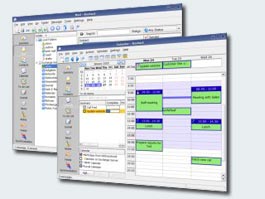Kontact
 |
Kontact est le gestionnaire d'informations personnelles intégré de KDE. |
La suite Kontact unit les applications PIM matures et éprouvées de KDE sous un même toit. Grâce à la puissante technologie KPart, les applications existantes sont parfaitement intégrées en une seule.
Les composants de KDE Kontact sont adaptés pour travailler les uns avec les autres. Les conséquences sont des fonctionnalités telles que le glisser-déposer intuitif entre la gestion de rendez-vous, les listes de tâches et les contacts. KDE Kontact supporte plusieurs serveurs de groupware. Quand vous utilisez ces serveurs, votre groupe de travail a accès à des fonctionnalités telles que les dossiers de courriels partagés, les listes de tâches de groupe, les calendriers partagés, les carnets d'adresses centralisés et les programmations de réunion.
En bref : KDE Kontact apporte des innovations pour vous aider à gérer vos communications plus facilement, à organiser votre travail plus rapidement et à travailler ensemble plus étroitement, ce qui a comme résultat une collaboration digitale plus productive et efficace.
Composants
Ces programmes peuvent être intégré à Kontact :
- Akregator - Lisez vos flux favoris
- KAddressBook - Gérez vos contacts
- KJots - Vos idées organisées dans des livres
- KMail - Client de messagerie
- KNode - Votre lecteur de messagerie usenet
- KNotes - Des notes autocollantes sur votre bureau
- KOrganizer - Journal, calendrier et planificateur
- KTimeTracker - Mesurez combien de temps vous passez sur diverses tâches
- Summary - Écran de résumé dans Kontact
Voir aussi
- Comment envoyer des SMS en utilisant Kontact
- Portage pour les appareils à écran tactile (comme les téléphones ou les tablettes) (actuellement maemo/Windows Mobile/MeeGo)
Où trouver de l'aide
Il ya une liste de diffusion à
- kdepim-users - for users of the KDE PIM applications (Kontact, KAddressBook, KMail, KOrganizer, KNode, ...) subscribe to kdepim-users archive of kdepim-users. A team of developers and users aim to give answers as quickly as possible
and for urgent help, an IRC channel on Freenode
- for users and developers of Kontact - #kontact
Akonadi and KAddressBook
If you have problems concerning Akonadi and the new KAddressBook, there are pages dedicated to these issues
FAQ, Hints and Tips
Migrating your setup to a new distro
In KMail, right click on your Inbox and choose Properties. Go the Maintenance Tab. Have a look at the Location. It has either .kde4 or .kde in the path.
Substitute the appropriate path below.
You need the following config files:
- .kde4/share/config/emaildefaults
- .kde4/share/config/emailidentities
- .kde4/share/config/kmail.eventsrc
- .kde4/share/config/kmailrc
- .kde4/share/config/kaddressbookrc
- .kde4/share/config/kresources/contact
- .kde4/share/config/korgacrc
- .kde4/share/config/korganizerrc
- .kde4/share/config/knotesrc
- .kde4/share/config/mailtransports
And the following directories:
- .kde4/share/apps/kmail
- .kde4/share/apps/kabc
- .kde4/share/apps/korganizer
- .kde4/share/apps/knotes
If you use Akregator within Kontact, you will also need:
- .kde4/share/config/akregator.eventsrc
- .kde4/share/config/akregatorrc
And the whole .kde4/share/apps/akregator directory.
Of course the simplest way is just to keep your whole home directory.
Just a word of warning. If the directory naming is different between Desktops or between the two versions of your distro, this will not work as there are references to the directories within the config files. This means that if the files were in a .kde directory, you cannot just put them in a .kde4 directory without editing the references within the config files.
Hiding the Kontact Sidebar
On small screens, you may wish to reclaim the space used by the Kontact sidebar. You can replace it with an (editable) toolbar:
- Drag the left panel closed using the splitter between it and the main panel, job done.
Enabling SOCKS support in KMail and KNode
Unlike KDE 3, KDE 4 does not have built-in SOCKS support yet. However, it is still possible and relatively simple to make KMail and KNode use a SOCKS proxy, by using proxychains or other similar tools like tsocks or socksify. Assuming that proxychains is correctly installed and configured, all you need to do is to open a terminal (e.g. Konsole) and type:
proxychains kdeinit4
You don't even need to restart KMail/KNode! (You need to type the above command every time you start a new KDE session though).
